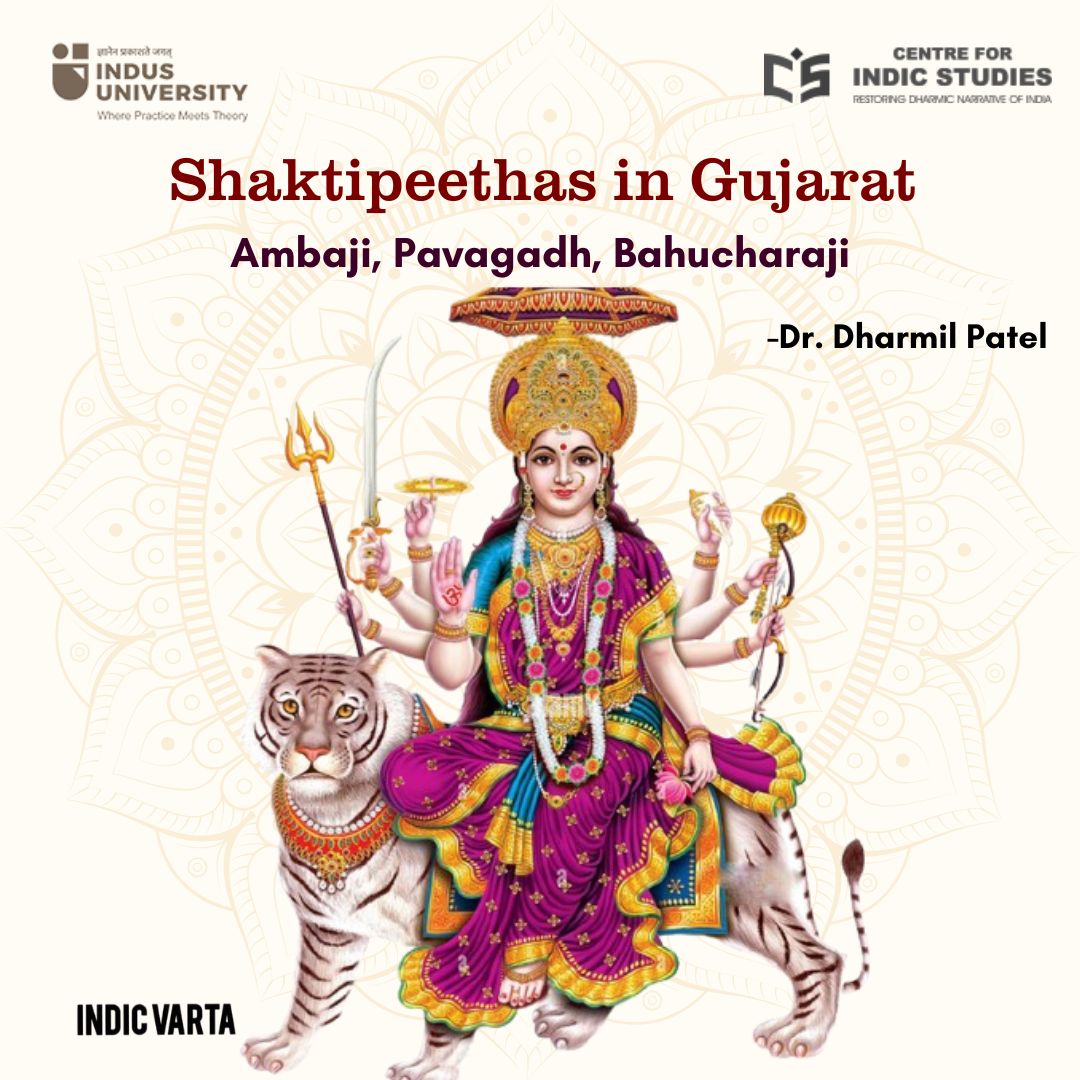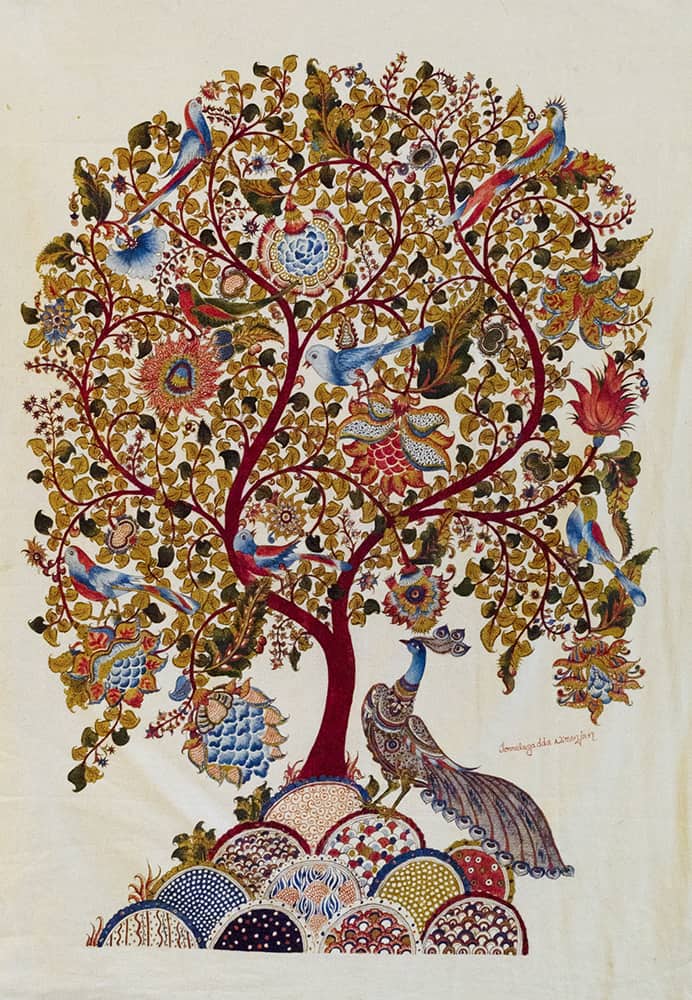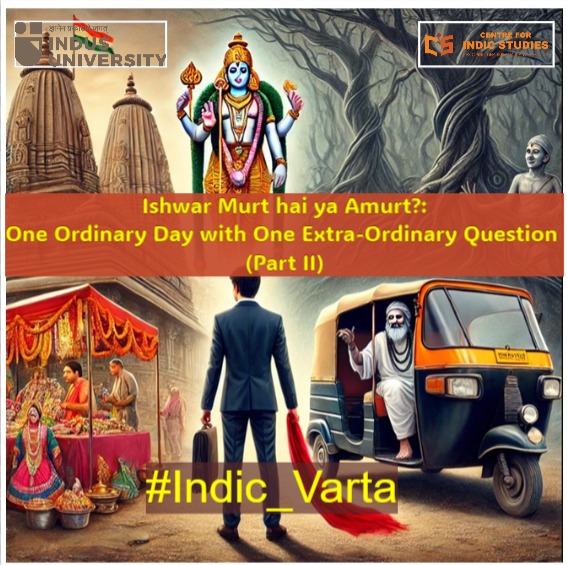- Visitor:102
- Published on: 2025-07-30 03:51 pm
Shaktipeethas in Gujarat: Ambaji, Pavagadh, Bahucharaji
The Shaktipeethas or Satipeethas are significant shrines and pilgrimage destinations in Shaktism, the mother goddess denomination in Hinduism. The shrines are dedicated to various forms of Aadi-Shakti. Various Puranas such as Shrimad Devi Bhagavatam state the existence of a varying number of 51, 52, 64 and 108 Shaktipeethas.

Shaktipeeth Ambaji:
Shaktipeeth Ambaji is located near the border of Gujarat and Rajasthan on the northern side of Gujarat and amidst the mountain ranges of Aravali. Ambaji is the principal shrine of a goddess who has been worshiped since the pre-vedic period. She is often referred to as Arasuri Amba, named for the location of the temple in the Arasur hills, near the source of the Saraswati river at the south-western end of the Aravali mountain range. Ambaji mata temple is one of the 51 Shaktipeethas. It is a major Shaktipeeth of India.
The temple is made of white marble with gold cones. The temple was originally built by Nagar Brahmins. There is a main entrance in the front and only a small side-door, because it is believed that Mataji (Maa Ambaji) has forbidden the addition of any other door. The temple is surrounded by an open square called chachar-chowk where ceremonial sacrifices called havan (Yagna) are performed.
The inner sanctum of the temple has silver-plated doors. There is a gokh, or niche, in the wall on which is fixed an old-plated marble inscription of the Viso Yantra, a Vedic text on sacred geometry, which is the main focus of worship. There is no idol of the goddess, perhaps because the temple is so ancient that it predates idol-worship, but the priests decorate the upper portion of the gokh in such a way that it looks like an idol of a goddess from a distance.
The temple on the Gabbar hill, considered the original abode of the goddess. The world's largest mythological light and sound show is the main attraction on the Gabbar hill, in which the entire mountain has been highlighted. At a short distance from the Ambaji temple is a large rectangular kund, with steps on all its four sides, called Mansarovar.
The ecstatic festival of Navratri is celebrated all over Gujarat in reverence of Ambaji, by dancing garba around the Holy Mother. On these nine nights, the Nayak and Bhojak communities also perform Bhavai theater. A large fair on Bhadarvi poornima (full moon day) is held here where people from all over the country come here walking all over from their native place. The whole Ambaji town is lit up as the nation celebrates the festive time of Diwali.
Ambaji is a world famous place of pilgrimage. It has been mentioned in the puranas that earlier there was a forest called Ambika Van here. Ambaji is situated at the height of 1580 ft. from the sea level. In the temple of Ambaji, the actual idol of the goddess is not worshiped. Instead pooja of the Visa Yantra is performed in the temple. According to the belief, the Yantra placed in the sanctum Santorum is associated with the original yantra placed inside the Shaktipeethas at Ujjain and Nepal. The yantra is believed to have fifty one letters. The pooja on the yantra is performed on the "ashtami" of each month. The flow of pilgrims here continues throughout the year unabated. However, on the full moon day, the pilgrims visit this place in large numbers to offer flags to the temple. From the religious point of view. Ambaji is a very significant Shaktipeeth in India. This place is believed to be the source of river Saraswati and the famous ancient abode of "Adyashakti". The ancient abode of goddess Amba is located in a cave at the peak of mountain Gabbar at a distance of two kms. from Ambaji. The Navaratri festival is celebrated with tremendous enthusiasm at Ambaji. A fair is held here on the day of Bhadaravi Poornima each year. Pilgrims travel on foot from far flung places to come to Ambaji and have a Darshan of the goddess. They feel blessed in doing so.
Devi Shakti is the incarnation of the supreme Cosmic Power of the Universe or Adyashakti and she is responsible for vanquishing evil. The Goddess emerges as a circle of light with weapons on all sides and she is also worshipped as Mahishasura Mardini. The devotees who flock to Ambaji temple also worship the divine cosmic power who is incarnated as Ambaji. The temple signifies the heart of Goddess Shakti and is one of the major Shakti Piths in India.
Mythology says that the original temple is dedicated to Maa Ambe Aarasuri and it is built on top of a hill called Gabbar Hillock. This is the site where the heart of Goddess Sati fell after her body disintegrated into 51 sacred pieces post the Tandav dance of Shiva. The original Danta temple was worshipped by devotees till the King of Danta fervently requested the Goddess to reside in Danta. The Goddess granted his request with one condition that the king should not look back even one time till he reached the temple of Danta. In case he failed to do so the Goddess would not shift. The king accordingly led the Goddess towards the site of Danta. The anklets of the Goddess tinkled and seemed to signal her movements behind the king. However, the king could not resist his curiosity and peeped back for a small look. The Goddess (true to her word) refused to budge even an inch and the disappointed king had to go away. The place where the Goddess stopped her sojourn was the site of Ambaji temple. Some pilgrims consider their visit incomplete till they have visited both Ambaji temples.
Ambaji is lauded as the supreme cosmic controller of the world.
Adequate precautions have been taken that the Yantra can be worshipped but not photographed. Even devotees are asked to tie their eyes with a white cloth before they are allowed to worship the Yantra. History says that the Ambaji temple has a strong Tantric past and the famous revered Batuk Tantrik is associated with this temple.
Shaktipeeth Pavagadh:
According to ancient religious tradition, the right toes of Goddess Sati, also known as Goddess Mahakali, are believed to be resting on the top of Pavagadh mountain. This sacred site holds immense significance for devotees of the goddess, who gather here to offer prayers and seek blessings. The Pavagadh mountain is located in the western state of Gujarat in India, and the legend of Goddess Sati is deeply rooted in Hindu mythology. It is said that the goddess sacrificed herself in a fire pit, and her body parts fell in different parts of the country, each of which became a sacred site for devotees. The presence of the goddess's right toes atop Pavagadh mountain draws countless devotees to this holy site every year.
Approximately 500 years ago, the Hindu kings were forcefully dispossessed due to the cruel invasion led by Muhammad Begda. As a result of this invasion, the majestic spire and flag of the Kalika Mata temple, which was a significant religious site for the Hindus, were destroyed.
In April 2022, India's Prime Minister inaugurated the first phase of a redevelopment project. The project aimed to enhance and modernize the infrastructure of a holy site, with a focus on restoring it to its former glory while preserving its historical and cultural significance. The construction of new buildings and facilities was done to support the needs of people visiting the site. The restoration work included repairing and renovating buildings, monuments, and other structures. Overall, the project has been a huge success, transforming the site into a modern, safe, and accessible destination for people from all walks of life.
Shaktipeeth Bahucharaji:
Goddess Bahuchara Temple Dedicated to Devi Bahuchara is located in the town of Becharaj near the village Chanasma of Patan district. Bahucharaji Mata Temple is one of the Shaktipeethas since it is held that Devi Sati’s hands fell here. The original temple complex was built in 1783 AD and is decorated with intricate stone carvings.
This temple is historic and one of the most visited temples of Gujarat. People from all around the world come to seek the blessings of the goddess Bahuchara.
At this Bahucharaji Mata Temple, the goddess is worshipped in the avatar of Shri Balatripur Sundari. According to the Purana, the Chunval region around Bahucharaji was ruled by a demon called Dandasur. The capital of the Chunval region was Daityarajpur (today's Detroj). Legends have it that the goddess Bahuchara had slain Dandasur and liberated the gods from his clutches.
The vehicle of goddess Bahuchara is a cock. During the Solanki era and in the golden period, the mark of a cock was printed on the flag as a symbol of the state. Bahuchara Mata carries a sword on her top right, a text of scriptures on her top left, the Abhay Hasta mudra on her bottom right, and a trident on her bottom left. She is seated on a rooster, which symbolizes innocence. As the Goddess of Fertility, pilgrims are taken to this site for vows fulfilled and boons granted.
Legend - Bahuchara Mata is a Hindu goddess. She was a daughter of a Charan by the name of Bapaldan Detha. She and her sisters were on a journey with a caravan, when a marauder named Bapiya attacked their caravan. It was common practice among charan men and women, if overpowered by their enemies, not to surrender but to kill themselves. Shedding the blood of charan was considered a heinous sin. When Bapiya attacked the caravan, Bahuchara and her sisters announced tragu (self-immolation) and cut their breasts.
Legend tells that Bapiya was cursed and became impotent. The curse was lifted only when he worshiped Bahuchara Mata by dressing and acting like a woman. Today Bahuchara Mata is considered patroness of the Hijra community in India, and worshipped by them and many other communities in Gujarat.
References:
1.https://en.wikipedia.org/wiki/Shakta_pithas
2.https://www.gujarattourism.com/north-zone/banaskantha/ambaji-temple.html
3.https://yatradham.gujarat.gov.in/TempleDetails?templename=FlASES//W+68xNx9vFV 8xg==
4.https://www.gujaratexpert.com/ambaji-history/
5.https://www.pavagadhtemple.in/about
6.https://jyotirlingatemples.com/article/id/8190/temple/451/the-shri-bahucharaji-mata-temple-mehsana
- 51 min read
- 2
- 0










